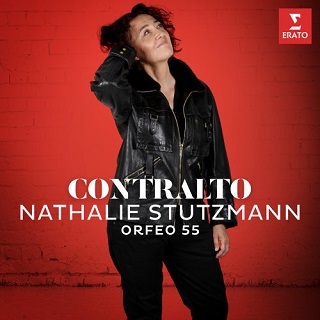We’re used to thinking of castrati as the operatic superstars of the 18th century. Even today one can readily bring to mind the names Farinelli and Senesino from among hundreds of compliant (or not so compliant) boys who would later become stage sensations. Nathalie Stutzmann shines a light on music written for her less revered female predecessors whose voices were often overlooked during the Baroque era by their more prestigious male colleagues. That some of these contraltos had distinguished careers is evident from the leading operatic roles assigned them, and each of the arias on this recent disc (with excellent booklet notes by Suzanne Aspden who reminds us that the term contralto originally meant a low-voiced castrato) is associated with a named singer from an original operatic performance.
Aspden notes that early 18th-century opera composers saw the female contralto and the male castrato as vocally interchangeable, and ‘that the voice most closely resembling a castrato is not the countertenor … but the contralto, which is a natural voice’. Natural it may be, but Stutzmann’s voice is an extraordinary voice, in both its range and expressive power. She fully realises the dramatic potential of her operatic heroines, drawn here from Handel and Vivaldi, with five world premiere recordings by the less celebrated, but no less musically productive contemporaries: Bononcini, Caldara, Gasparini, Lotti (purely instrumental contributions) and Porpora. Stutzmann also reveals herself as a more than capable conductor, directing with customary aplomb her period instrument ensemble, Orfeo 55, now regrettably dissolved.

Immediately apparent with Stutzmann’s fruity contralto is its tonal similarity to a countertenor, yet her range goes beyond most male altos to encompass areas above and well below the stave. Regardless of the occasional ‘Hinge and Bracket’ leap through the registers, it’s a voice with authority and unflagging agility. Once or twice I felt brow-beaten by the sheer force of her personality. But that’s not to deny the quality of her artistry or the panache with which she zips through some of the more energetic numbers such as Handel’s ‘Mio cor, che mi sai dir’ (Rinaldo) where her fevered resolve is matched by ardent string playing; undeniably pulse-raising in its vitality. Equally, in ‘Sento il cor per ogni latto’ (Arminio) one is swept away by its fiery intensity where Stutzmann pours her heart and soul into the endangered Ramise. She is indisputably in her element. Combine that with the martelé strings and a homicidal tempo, and this is one of the disc’s highlights. Its brilliance is almost matched by the dynamism of ‘Vado, vado al campo’ (Sosarme), her pugnacity enlivening every bar, vocal gear changes and a quasi-cadenza adding extra frisson. There’s some fine bassoon playing too in Handel’s ‘Dal crudel che m’ha tradita’ (Tamerlano).
Of the handful of Vivaldi arias, the ornamental ‘De verde ulivo’ (Tito Manlio) gives prominence to the cello, while the scena that is ‘Gelido in ogni veda’ (Farnace) provides an opportunity to hear Stutzmann’s room-stilling pianissimo and finely spun legato. Her expressive range is displayed to advantage in the recitative and succeeding aria ‘Suena, uccidi, abbatti atterra’ (Bajazet), although it’s a shame the overwrought characterisation brings some strained high notes.
Elsewhere, Stutzmann reins in the melodrama and makes a strong case for Bononcini’s consoling ‘Caro addio dal labbro amato’ (Griselda), reducing her generous tones to match the intimacy of the theorbo and single violin, bringing a welcome remoteness, and closing this lament with peerless sensitivity. Flute, chalumeau and bassoon arrest the ear with their woody sonorities in Caldara’s wistful ‘Sotto un faggio o lungo un rio’ (Euristeo), its pastoral mood nicely mirrored by its relaxed delivery. Similarly, the siciliana that is Gasparini’s ‘Empia mano’ (La fede tradita e vendicata)gains much from Stutzmann’s restraint. Three emotionally charged arias by Nicola Porpora make clear her expressive variety with fabulously floated high notes in the numbed grief of Ericlea in Meride e Selinunte, venomously spat out consonants in Semiramide and molten fury in the treachery of Statira, Stutzmann’sgloriously resonant chest register plumbing new depths.
Amongst the instrumental numbers, there’s a hard driven Handel Overture to Ariodante and a rather cramped-sounding Sinfonia from Berenice that would benefit from a little more air between the phrases. Curiously the twenty-one CD tracks concludes with a three movement Sinfonia to Vivaldi’s L’incoronazione di Dario. To hear Stutzman one last time, you need the digital version (six extra numbers) for Handel’s heart breaking ‘Sorge nel petto’ (Rinaldo). With eloquent solo violin and theorbo, it’s gloriously rendered and leaves you wanting more.
David Truslove
Nathalie Stutzmann (contralto/director), Orfeo 55
Bononcini – ‘Caro addio dal labbro amato’ (Griselda)*; Caldara –‘Sotto un faggio o lungo un rio’ (Euristeo)*; Gasparini – ‘Empia mano’ (La fede tradita e vendicata)*; Handel – Overture to Amadigi di Gaula,Overture to Act 2 Ariodante, Sinfonia to Act 3 Berenice, ‘Dal crudel che m’ha tradita’ (Tamerlano), ‘Mio cor, che mi sai dir’ (Rinaldo), ‘Sento il cor per ogni latto’ (Arminio), ‘Vado, vado al campo’ (Sosarme); Lotti – Sinfonia to Act 3 (Alessandro Severo)*; Porpora –‘Mira d’entrambi il ciglio’ (Statira)*,‘Torbido intorno al core’ (Meride e Selinunte), ‘Tradita sprezzata’ (Semiramide riconosciuta); Vivaldi –‘De verde ulivo’ (Tito Manlio), ‘E morto si tiranno … Suena, uccidi, abbatti atterra’ (Bajazet), ‘Gelido in ogni veda’ (Farnace).
* world premieres
Digital/bonus tracks: Handel – ‘Sorge nel petto’ (Rinaldo), Overture Andante larghetto to Berenice; Lotti – Overture to Alessandro Severo (tracks 23-25); Vivaldi – ‘Degli Elisi dal soggiorno’ (Ginevra, principessa di Scozia).
Erato 0190295209551 [80:19]
ABOVE: Nathalie Stutzmann (c) Simon Fowler